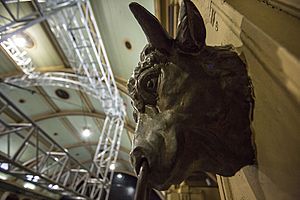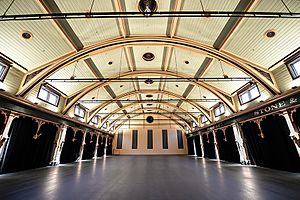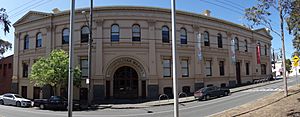Metropolitan Meat Market facts for kids
The Meat Market is a famous old building in Melbourne, Australia. It used to be a place where meat was sold. Today, it's a lively arts and culture center.
The building was designed by George Johnson and finished in 1874. It's been recognized as an important historical site since 1973. The Meat Market now hosts many cool events. These include theatre shows, circus acts, dance performances, and even food festivals. It's also a key venue for big festivals like the Melbourne Fringe Festival and RISING.
Contents
A Look Back: Meat Market's History
The Meat Market was built in 1880. It was created to be a large place for selling meat. For many years, it was a busy trading spot. However, it stopped being a meat market in 1974.
The building then sat empty for a few years. In 1977, the government bought it. They decided to turn it into an arts center. It officially opened as an arts center in 1979. The space was used for offices and workshops by artists. It also housed different arts and crafts groups. In 2004, the building was updated with more office space.
Today, the City of Melbourne manages the Meat Market. It has become a major place for arts and culture. More than 50 artists and arts businesses work there. The Meat Market is a vital part of Melbourne's art scene. It hosts hundreds of events every year. These events include parts of the Melbourne Fringe Festival and Yirramboi.
How the Meat Market Was Built
George R. Johnson designed the Meat Market in 1879. He was an architect from London. Johnson was chosen because he had experience designing other markets. He also designed the Hotham Town Hall, now called Melbourne Town Hall.
The building was a big project. It was planned to be built in stages. The first part was finished between 1879 and 1880. This included the main market hall and offices. It also had a hotel section.
Later, more parts were added. A bank and manager's living areas were built. A gate and a facade connecting to the hotel were also added. Shops and a caretaker's home were included too. The entrance between the gate and the market hall was left open at first.
In 1889, a cooling room was added. George R. Johnson was hired again for this. He made sure the new part matched the old building. This area is now the North Melbourne entrance.
Changes and Early Uses
In 1890, the building needed major plumbing work. George Johnson had passed away by then. The firm Gibbs and Finlay took over the work. This firm made big changes to the market from 1906 to 1908. They extended the main hall to the north. This added more stalls, matching the original design. They also built a new cooling room and a new entrance.
More changes were made between 1918 and 1922. Offices were added for the Master Butcher's Association. New cooling rooms were built along both sides of the market hall.
The Meat Market was not the only market of its kind. But it was the biggest private market in Melbourne. It was run by the Metropolitan Meat Market Company. This company operated the market for 94 years, until June 1974.
Becoming a Craft Centre
In 1973, the Meat Market building was put up for sale. It was a good time for real estate prices. Developers were interested because it was a large area near the city. However, the building was protected as a historical site. This meant it could not be knocked down. So, developers were no longer interested. The building did not sell at auction.
It remained unsold for almost three years. During this time, it was used for different things. It was a warehouse, an auction room, and even a car park. No one could find a good business use for it.
In 1975, an artist named David Wright had an idea. He suggested turning the old meat market into a craft center. This idea came at the perfect time. The Craft Association of Victoria needed a better place to work. They had trouble moving their equipment.
A group of people inspected the building. They agreed it would be great for crafts. The Craft Association then asked the Victorian Ministry for the Arts to buy the market. There was a worry that the historical protection might be removed. But luckily, the decision was made to keep the market protected.
In 1976, the government agreed to study the idea. They hired architects to see if it was possible.
Government Buys the Building
Soon after the study, the government decided to buy the Meat Market. In January 1977, the purchase was completed. It cost $890,000. The building became government property.
For the next two years, committees worked on plans. They oversaw repairs and looked for tenants. They also developed a vision for the center. In May 1979, Marjorie Johnson was appointed as the Interim Manager. Her job was to get the Meat Market ready to open as a Craft Centre.
The Craft Centre officially opened on November 8, 1979. It displayed the Victorian State Craft Collection. It also showed art from local students. A Board of Management was set up to run the center.
In 1980, Marjorie Johnson became the General Manager. The Board set goals for the center. They wanted workshops for different crafts. They also planned for craft shops, exhibitions, and a conference center.
At first, only exhibitions and the Blackwood Street Gallery were open. In 1981, a craft shop was added. This shop sold high-quality Australian crafts to tourists. In 1982, ceramic and textile workshops were set up.
More funding was needed to fully restore the building. In 1983, the government announced a large grant. This money allowed for the complete restoration of the Meat Market. All the planned activities could finally happen.
Meat Market Today
Since 1998, the Meat Market has been a space for creative and performing arts. After big renovations in 2005, a special team started managing it in 2015. Now, over 50 businesses and artists work from the building.
The Meat Market has four main spaces you can rent. These include the Flat Floor Pavilion and the Cobblestone Pavilion. There's also a Meeting Room and the Stables. The Cobblestone Pavilion is special because it has a circus truss. This allows for amazing aerial and circus performances.
Many creative groups also have offices inside the Meat Market. These "licensees" include music and dance organizations. Some well-known groups there are YIRRAMBOI Festival and the Melbourne Jazz Festival.
Fun Events at Meat Market
The Meat Market hosts many exciting events. Here are just a few:
- Emerald City, part of the Melbourne Fringe Festival
- Junipalooza (a gin festival)
- Melbourne Knowledge Week Hub
- Mould: A Cheese Festival
- MTV Unplugged Melbourne with Gang of Youths
- MTV Unplugged Melbourne with Amy Shark
- TedxMelbourne: The Great Unknown
- Broadsheet Melbourne and Connoisseur Ice Cream's Discovery Festival
- Melbourne Music Week: Melbourne Synth Festival






